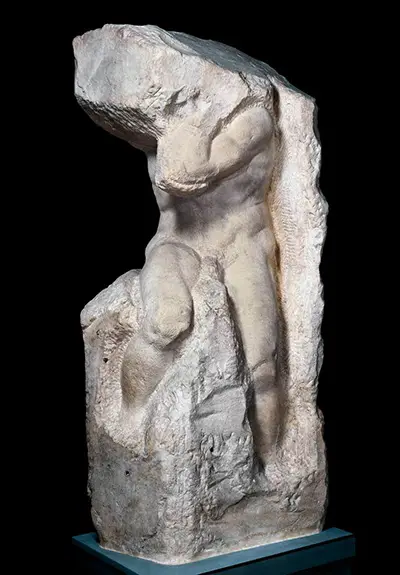The awe-inspiring statue is currently held in the Academia Gallery (Galleria dell'Accademia) in Florence.
In the Academia Gallery in Florence, the “Atlas Slave” is situated on the left down the corridor. The statue is of a male nude that seems to carry an enormous weight on his head. Consequently, he has been named after Atlas – the proverbial ancient Titan who held up the whole world on his shoulders.
His head has not come out of the stone, depicting the slave as supporting and pushing such an enormous weight, which kind of threatens to flatten him. The downward push of the immense weight, as well as the upward force of the slave pushing back up, creates a special kind of energetic tension.
Any feeling of equilibrium is totally lacking here, only an everlasting battle of forces that threaten to explode towards both directions. This special pressure exudes a power which seemingly more than the other slaves exhibits the sheer energy of the particular figure which is struggling to come out of the marble.
Dated around 1525-30, the Atlas is one of the four legendary statues at the Academia Gallery in Florence - aptly christened by scholars as: The Atlas (Also called Bound), The Bearded Slave,The Young Slaveand The Awakening Slave.
Perhaps the biggest reason why the four statues are exceptionally famous is because of their unfinished state. They represent some of the best examples of the iconic artist’s customary working practice, popularly referred to as “Non-finito” (meaning incomplete).
They are without doubt outstanding illustrations of the complexity the sculptor must have faced in carving out the figures from blocks of marble as well as symbolic of man’s constant struggle to free the spirit from matter.
The statues have been interpreted in numerous ways. Seeing them, in their different stages of completion, they bring to mind the immense strength of the creative concept as they seem to be trying to free themselves from the bondage as well as the sheer weight of the marble. There are claims that the genius sculptor—Michelangelo—left them incomplete deliberately in order to depict the eternal struggle of man to free himself from his material trappings.
Also famously referred to as the Florentine Prigioni, Atlas and the other three famous sculptures are believed to have been carved in the second half of the 1520s. This is at a time when Michelangelo was an employee at San Lorenzo, Florence.
However, historians have suggested that the four statues might have been carved anywhere between 1519 and 1534. It is said that they were found lying in Michelangelo’s warehouse (located on the via Mozza) in the year 1544; this at a time when the artist’s nephew, Leornardo Buonarroti, sought permission to put them on sale.
According to historical records, Michelangelo never visited Florence after 1534. The permission to sell the Florentine Prigioni was never granted. In 1564, the sculptures were donated to the Grand Duke Cosimo I, who is said to have then placed them at the four corners of the Grotto of Buontalenti in the year 1591. In 1908, they were moved from there, so as to be reunited with Michelangelo’s other works, in the Galleria dell'Accademiain Florence.
The Atlas Slave and all the other unfinished statues domiciled at Academia disclose the legendary artist’s approach as well as perception of carving. He strongly believed that a sculptor was God’s tool, not only in creating but also revealing the powerful figures already hidden in the marble.
Michelangelo’s brief was only to chip and tweak the extra matter in order to reveal what was therein. Rumour has it that the famous artist often worked for days on end without even having a wink of sleep, while wearing the same boots and clothes.
A keen observer can clearly make out the mallet grooves as well as the pointed chisel on the surface of the marble used in this preliminary stage. Unlike most of the other famous sculptors, who were known to prepare a plaster cast model and carefully marked up their marble block for guidance on where to chip, Michelangelo employed a freestyle modus operandi.
He normally started from the front and worked backwards. Some famous writers such as Vasari have described Michelangelo’s figures as seeming to emerge from the marble, as if sprouting from a pool of water. The process involved taking a wax figure, laying it in a vessel of water and gradually letting it emerge, hence first noting the most prominent parts. Therefore, the highest parts could be the first to get extracted from the marble.
Currently, there are two extra slaves, known as the Rebellious Slave and the Dying Slave (both dated 1510-13), which are now on display at the Parisian Louvre Museum. It is believed that, using his own hand, Michelangelo finished entirely two of captives—exquisitely charming figures—as well as other statues, better than all seen before. But eventually, they were never placed in their rightful positions.
The captives are said to have been presented by Michelangelo to Ruberto Strozzi, when the artist was lying indisposed in his house. They were later sent as special gifts to King Francis, and that is how they ended up in France. The famous statues leave no doubt about the exceptional genius that Michelangelo was.


